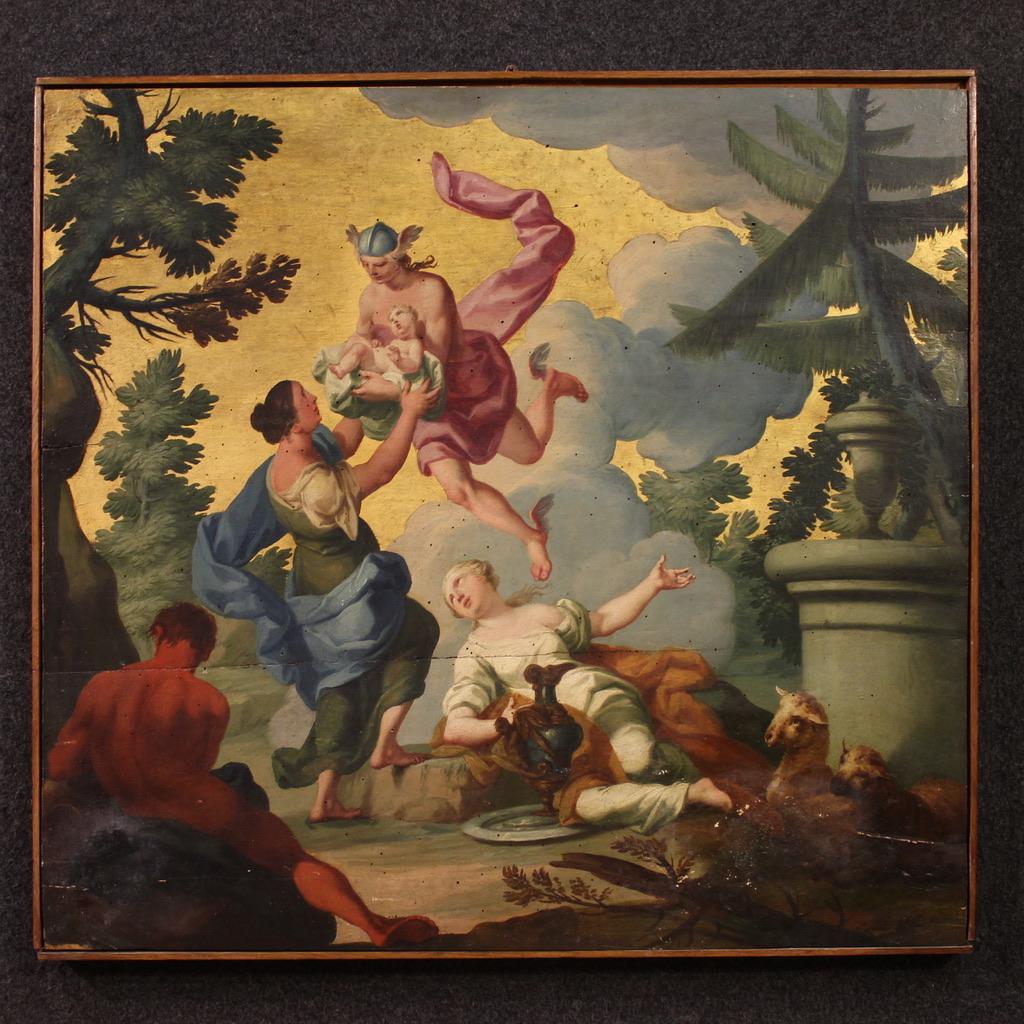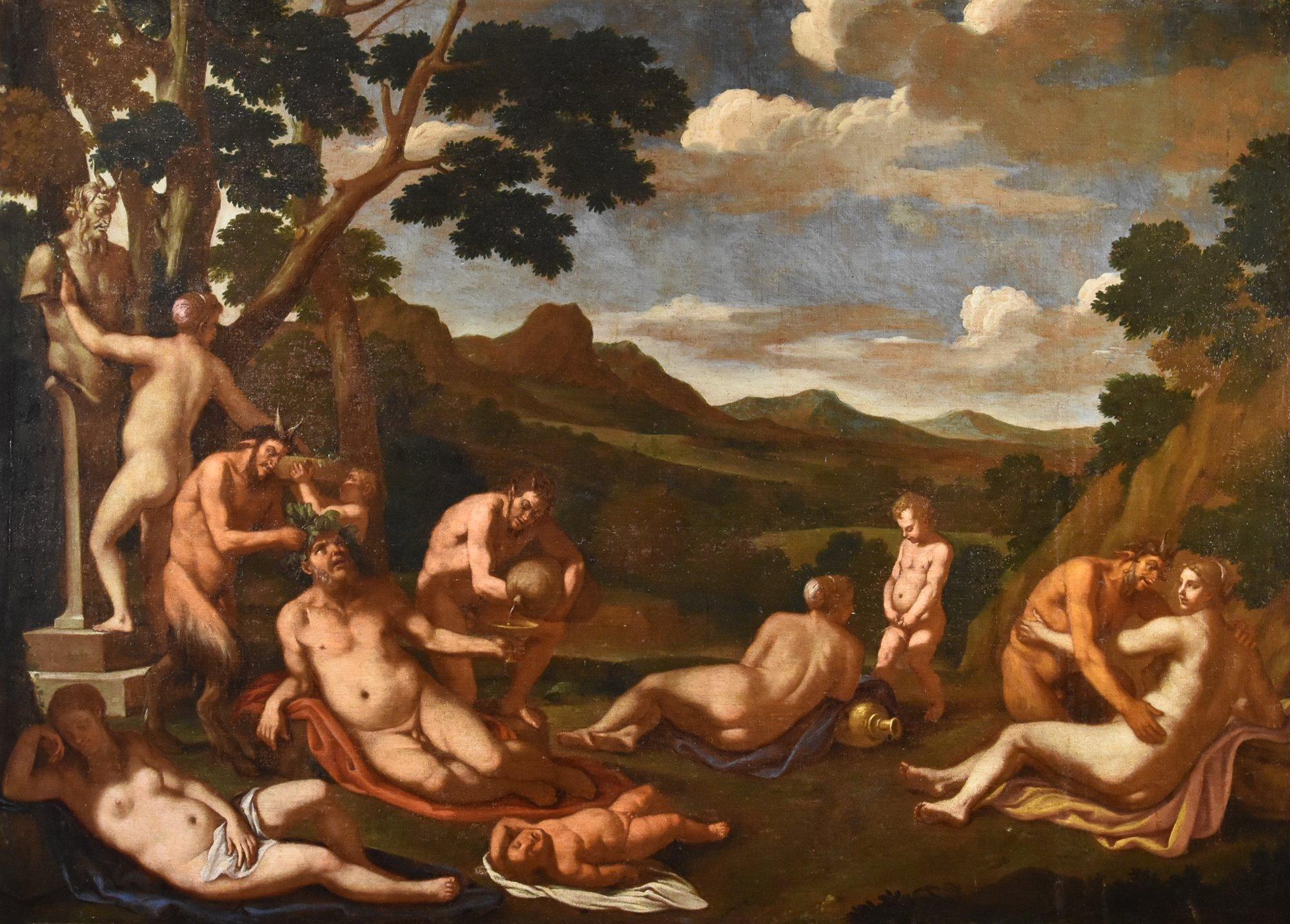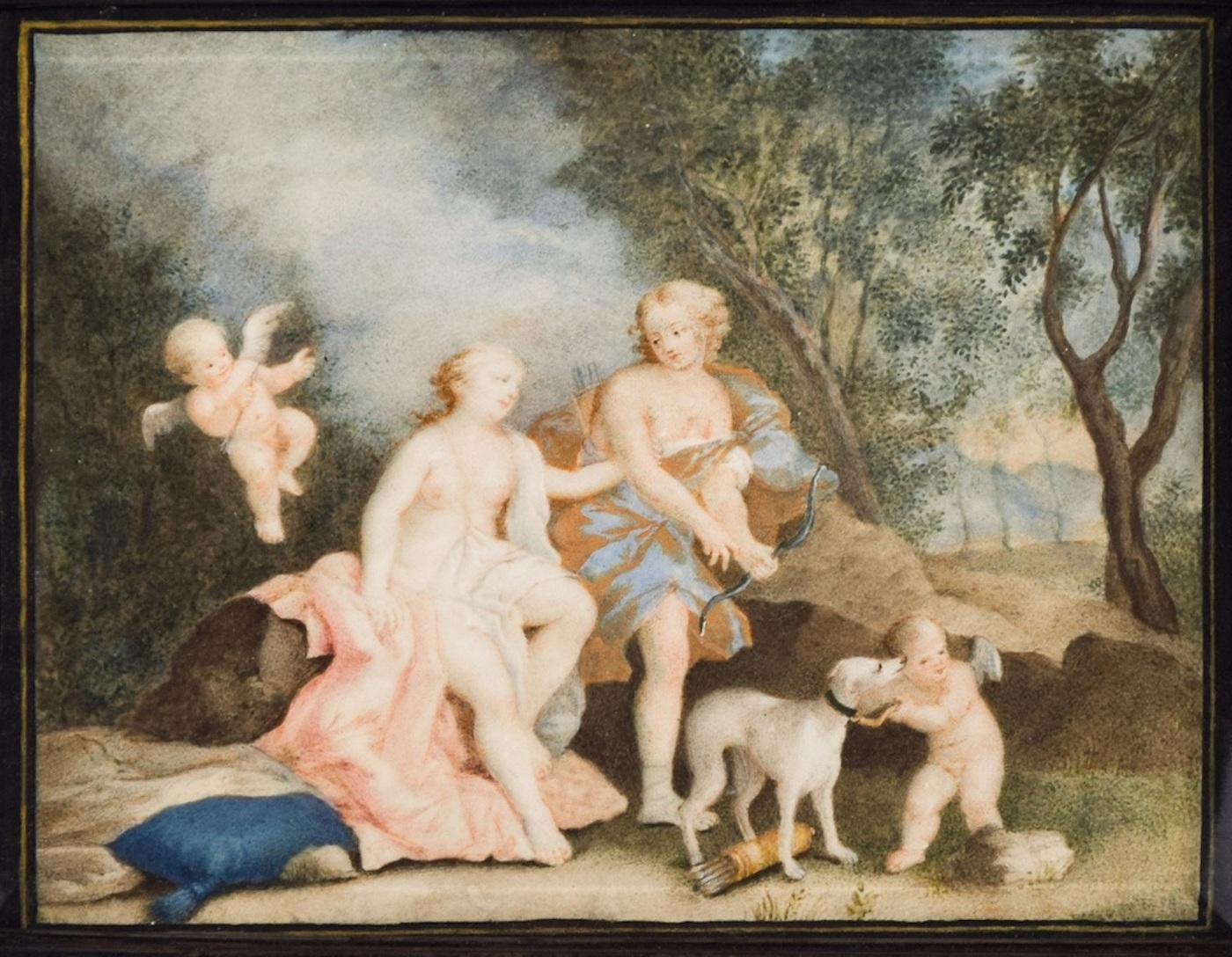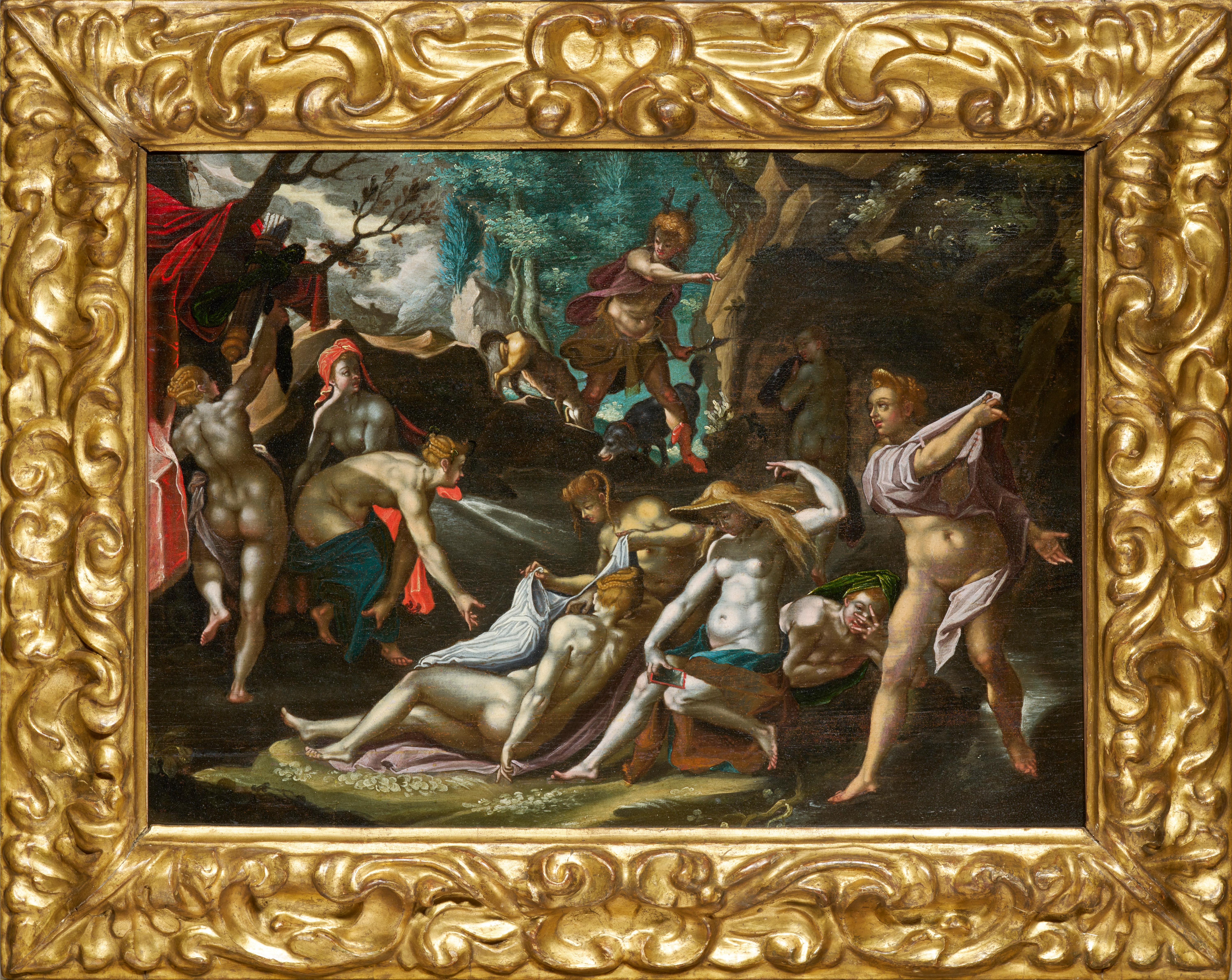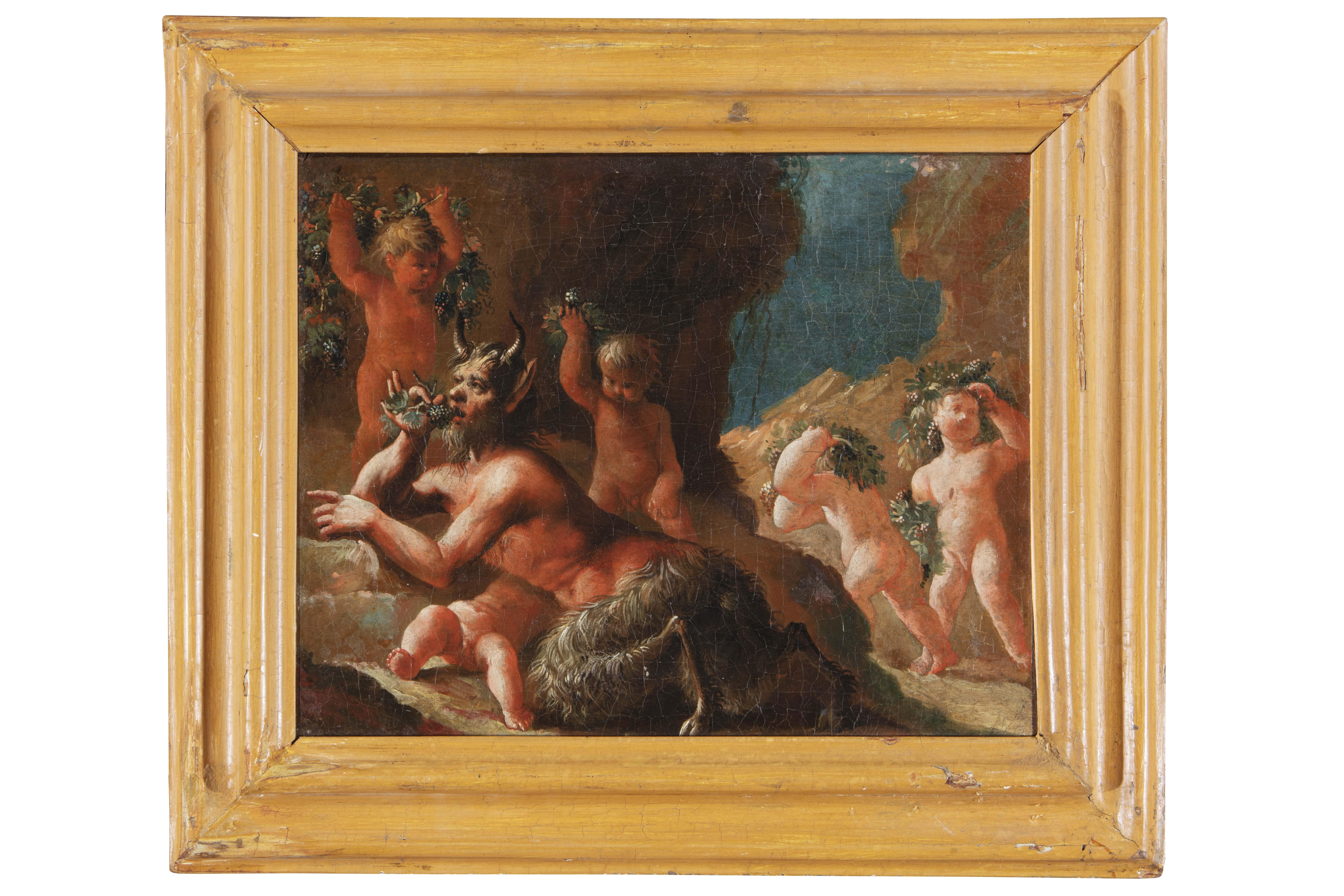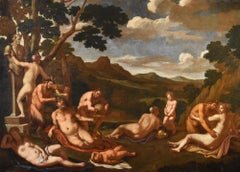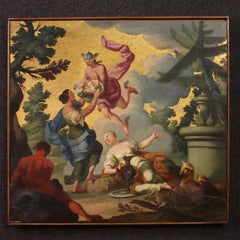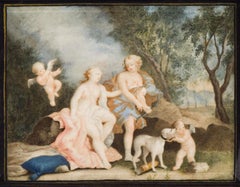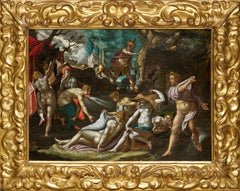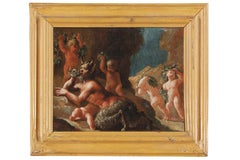Items Similar to Diana Boullogne Mythological Paint Oil on canvas old master 17/18th Century
Want more images or videos?
Request additional images or videos from the seller
1 of 14
UnknownDiana Boullogne Mythological Paint Oil on canvas old master 17/18th Century1670-1740
1670-1740
$8,466.78
$10,583.4720% Off
£6,282.39
£7,852.9920% Off
€7,072
€8,84020% Off
CA$11,825.12
CA$14,781.4120% Off
A$12,824.63
A$16,030.7820% Off
CHF 6,735.98
CHF 8,419.9820% Off
MX$155,777.69
MX$194,722.1120% Off
NOK 84,290.15
NOK 105,362.6920% Off
SEK 79,363.88
SEK 99,204.8620% Off
DKK 53,853.32
DKK 67,316.6520% Off
About the Item
Bon Boullogne (Paris, 1649 - Paris, 1717) workshop of
Episodes from the myth of Diana
oil painting on canvas
Dimensions: 84 x 114 cm.
with antique frame 100 x 132 cm.
The beautiful painting proposed shows a series of episodes taken from the myth of the divinity Diana, the Roman divinity of hunting, forests and wild animals, masterfully captured in this valuable painting, which shows a luxuriant wood, a favorite place of the divinity, as a theater of his adventures.
The composition opens, on the left, with a sort of presentation of the divinity, portrayed as an attractive young girl, surrounded by her faithful Nymphs, one of whom holds her quiver with arrows, and by one of her beloved dogs. hunting her.
The 'story' continues in the central part where we can see the divinity during a wild boar hunt, always with the goddess preparing to shoot a trail against a wild boar.
The other two scenes instead concern Diana's love life, in particular with Orion, a talented hunter with whom the divinity fell in love. The scene could represent a moment of intimacy between the two, interrupted by a curious satyr, surprised and punished by Orion himself with the help of a nymph.
To conclude, the author wanted to represent the tragic moment in which the goddess cries over the body of the beloved lying on the ground, killed by mistake by an arrow shot by Diana herself, the result of the trap hatched by the jealous brother Apollo, disappointed by the love that his sister felt for a mortal. Here we see Diana averting in vain Aesculapius, a divinity capable of resurrecting the dead, of reviving Orion as a young man, who instead will be transformed by Zeus into the constellation of the same name.
The painting is to be ascribed to the workshop of the painter Bon Boullogne (Paris, 1649 - Paris, 1717), an exemplary exponent of French painting of the second half of the seventeenth century and member of a dynasty of painters (he was the son of the painter Louis Boullogne, and brother of Louis, Geneviève and Madeleine, all active in their father's workshop), famous for their mythological compositions.
His stay in Rome, from 1670 to 1675, at the French Academy paid by Louis XIV, served to the painter to study the great Italian authors, shaping a style that on his return to Paris would make him extremely in demand with his painting of great decoration, suitable, then as now, to embellish high-level bourgeois residences.
In fact, in the canvas in question we find all the typical components of the whimsical French master, elaborated starting from most of the Italian painting of the 1600s, especially Roman and Bolognese, looking at the ways of the Carracci and Correggio, with a direct ancestry in particular from Domenichino (remember Diana's hunt in the Borghese Gallery), while the chromatic timbre of the entire composition is affected by the light and luminous tones of Reni, Maratti and Albani. The great tradition of early Roman Baroque painting is relived by Boullogne on a cultural basis that does not neglect even the influence of Nicolas Poussin.
The canvas is in a good state of conservation with the presence of several restoration points and a superficial oxidation layer.
The published photographs were made using a professional light so it is possible that the painting will be slightly darker if not adequately lit.
The work is accompanied by a beautiful gold frame, ancient but not contemporary.
ADDITIONAL INFORMATION:
The work is sold with a certificate of authenticity and a descriptive iconographic card.
We take care and organize the transport of the purchased works, both for Italy and abroad, through professional and insured carriers.
It is also possible to see the painting in the Riva del Garda gallery, we will be happy to welcome you to show you our collection of works.
Contact us, without obligation, for any additional information.
- Creation Year:1670-1740
- Dimensions:Height: 39.38 in (100 cm)Width: 51.97 in (132 cm)
- Medium:
- Movement & Style:
- Period:Late 17th Century
- Condition:
- Gallery Location:Riva del Garda, IT
- Reference Number:1stDibs: LU988110767212
About the Seller
4.9
Platinum Seller
Premium sellers with a 4.7+ rating and 24-hour response times
Established in 2017
1stDibs seller since 2018
261 sales on 1stDibs
Typical response time: 2 hours
- ShippingRetrieving quote...Shipping from: Riva del Garda, Italy
- Return Policy
Authenticity Guarantee
In the unlikely event there’s an issue with an item’s authenticity, contact us within 1 year for a full refund. DetailsMoney-Back Guarantee
If your item is not as described, is damaged in transit, or does not arrive, contact us within 7 days for a full refund. Details24-Hour Cancellation
You have a 24-hour grace period in which to reconsider your purchase, with no questions asked.Vetted Professional Sellers
Our world-class sellers must adhere to strict standards for service and quality, maintaining the integrity of our listings.Price-Match Guarantee
If you find that a seller listed the same item for a lower price elsewhere, we’ll match it.Trusted Global Delivery
Our best-in-class carrier network provides specialized shipping options worldwide, including custom delivery.More From This Seller
View AllBacchanale Mythological Carpioni Paint Oil on canvas 17th Century Old master Art
Located in Riva del Garda, IT
Giulio Carpioni (Venice, 1613 - Vicenza, 1678), Attributable to
Bacchanale
Oil on canvas 98 x 132 cm. - In frame 120 x 154 cm.
This high-quality, beautifully preserved painti...
Category
17th Century Old Masters Paintings
Materials
Oil
$15,937 Sale Price
20% Off
Landscape Reder 17/18th Century Pait OIl on canvas Old master
Located in Riva del Garda, IT
Christian Reder (Leipzig 1656 - Rome 1729)
Landscape with boar hunting
Oil on canvas 66 x 132 cm In frame 76 x 143 cm
We present this delightful work, of which the matching ...
Category
17th Century Old Masters Paintings
Materials
Oil
$6,101 Sale Price
20% Off
Toilet Venus Albani Mythological 17/18th Century Paint Oil on canvas Old master
Located in Riva del Garda, IT
Toilet of Venus Francesco Albani (Bologna 1578 - 1660) Follower of
Oil on canvas 64 x 96 cm In fine gilded frame 83 x 121 cm.
The painting on offer, depicting ‘Venus’ Toilet',...
Category
17th Century Old Masters Paintings
Materials
Oil
$9,587 Sale Price
20% Off
Diana Landscape Muller Signed Paint Oil on table 17th Century Flemish Old master
Located in Riva del Garda, IT
Jacques Muller (Utrecht 1630 - 1680)
Signed: 'J. Muller f(ecit).'
Pupil of Abraham van Cuylenborch (Utrecht, 1620 - 1658)
Diana and the nymphs bathing in a cave
Second half of the ...
Category
17th Century Old Masters Paintings
Materials
Oil
$9,711 Sale Price
20% Off
Thetis Hephaestus Blanchard Mythological Paint Oil on table 17th Century French
Located in Riva del Garda, IT
Jacques Blanchard (Paris, 1600 – Paris, 1638) and workshop
Thetis in Hephaestus' forge (Hephaestus gives Thetis the weapons he forged for Achilles)
Oil on canvas applied to pan...
Category
17th Century Old Masters Paintings
Materials
Oil
$9,338 Sale Price
20% Off
The Resting Of Diana, Guillaume Courtois Known As 'il Borgognone' (1626 - 1679)
Located in Riva del Garda, IT
Guillaume Courtois known as 'il Borgognone' (Saint Hippolyte 1626 - Rome 1679)
The Resting of Diana
Oil on canvas (97 x 70 cm. - Framed cm. 121 x 95)
The proposed painting, of exqui...
Category
17th Century Old Masters Paintings
Materials
Oil
$7,346 Sale Price
20% Off
You May Also Like
18th Century Oil on Panel Italian Mythological Painting, 1760
Located in Vicoforte, IT
A rare 18th-century Italian painting. Oil on panel artwork depicting a captivating mythological subject, Mercury delivers the infant Bacchus to the Nymphs of Mount Nysa. According to...
Category
1760s Figurative Paintings
Materials
Oil, Wood
Mythological Scene - Oil on Board - 18th Century
Located in Roma, IT
Mythological Scene is a mixed colored painting on board realized by Anonymous artist in the XVIII century.
The artwork represents a mythological scene with women and cherubs.
Inclu...
Category
18th Century Figurative Paintings
Materials
Board, Oil
Diana and Actaeon, a Mannerist painting after Joseph Heintz the Elder
Located in PARIS, FR
This painting seduced us with its rich colors. Depicting Diana and her companions surprised by Actaeon, it was inspired by an engraving by Aegidius Sadeler II after a painting by Jos...
Category
17th Century Old Masters Nude Paintings
Materials
Oil, Wood Panel
18th century By French Maestro Bacchanal Oil on canvas
Located in Milano, Lombardia
18th Century French Maestro
Title: Bacchanal
Medium: Oil on canvas
Dimensions: without frame 24 x 30 cm - with frame 33.5 x 39 cm
Antique shaped wooden frame lacquered in mustard col...
Category
18th Century Old Masters Figurative Paintings
Materials
Oil, Canvas
$10,727 Sale Price
20% Off
French School of the 18th Century : Mythology, Bacchanalia - Oil on canvas
Located in Paris, IDF
French School of the 18th century
Mythology : Bacchanalia
Oil on canvas
Unsigned
On canvas 43 x 34 cm
Presented in a gilded carved wooden frame 58 x 49 cm
Very good condition, smal...
Category
Early 18th Century Academic Figurative Paintings
Materials
Oil
Hercules and Omphale - Oil Painting on Canvas - 18th Century
Located in Roma, IT
Hercules and Omphale is an original painting realized in France between the end of the 18th and the beginning of the 19th Century.
Original oil painting on canvas. Dimensions: 73 x...
Category
Late 18th Century Modern Figurative Paintings
Materials
Canvas, Oil
More Ways To Browse
Old Masters Paintings In Gold Frames
17th And 18th Century Oil Paintings
Unknown Master Painting
Italian Oil Painting Old Man
Antique Hatch
Antique Traps
Antique Wild Boar
Antique Paintings Mythological
Nicolas Poussin
Oil Paintings 17 Century
Oil Painting Mythological
Diana Of The Hunt Painting
Diana Painting 17th Century
Roman Baroque Painting
Diana Painting 18th Century
Textured Acrylic
Vintage California Art
Graffiti Art
